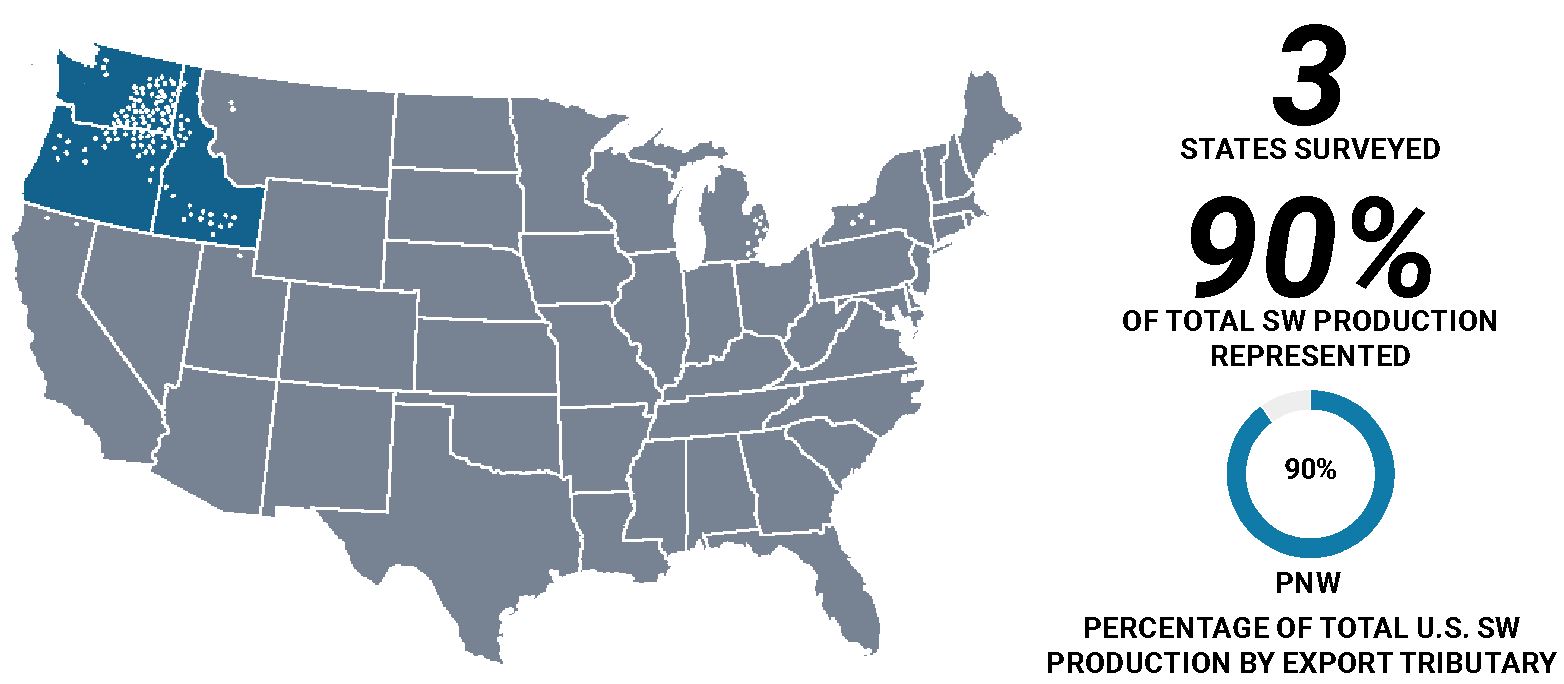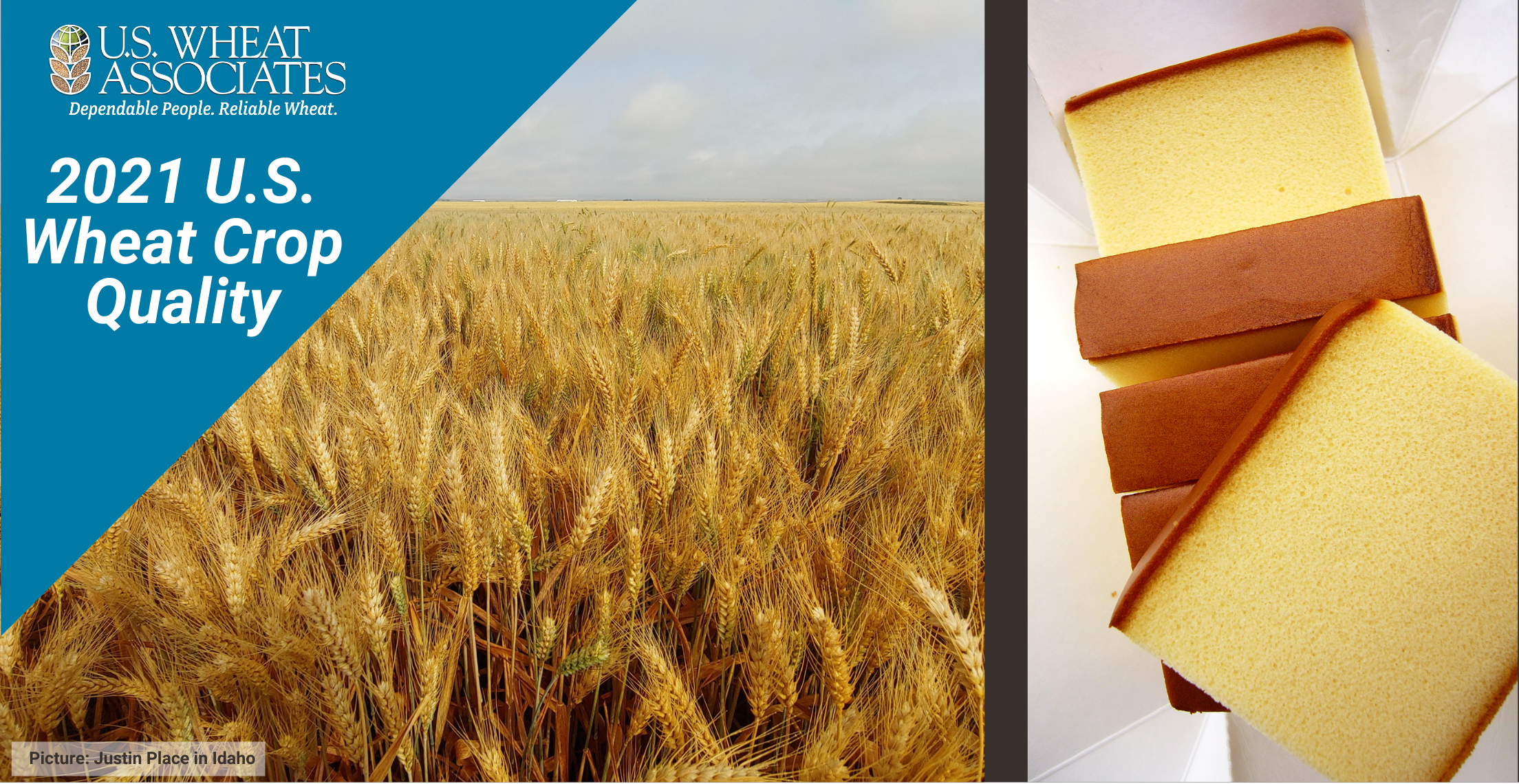The Pacific Northwest (PNW) experienced challenging drought conditions in the 2021 soft white crop year, resulting in a wheat crop with higher protein and lower yields. This year’s SW crop has weak to medium gluten strength and acceptable finished product characteristics. SW is especially suited for use in cakes, pastries, cookies and snack foods. The high protein segment of the SW crop provides opportunities in blends for crackers, Asian noodles, steamed breads, flatbreads and pan breads. With very weak gluten strength, Club White is typically used in a Western White blend with SW for cakes and delicate pastries.

Weather and Harvest
Winter planting conditions were generally good, including sufficient moisture overall to develop a strong stand; however, less winter moisture impacted crop development coming out of dormancy. Spring planting conditions were poor due to the very dry conditions and excessive heat throughout much of the PNW.
As the crop developed, extreme sustained heat in late June accelerated crop maturity in many areas, which put the harvest timeframe generally ahead of average. Production of the 2021 PNW SW crop is estimated at 4.3 MMT, the lowest for the region since 1966.
Buyers are encouraged to review their quality specifications to ensure that their purchases meet their expectations. This will be a good year to understand SW protein performance versus protein levels; your local U.S. Wheat Associates (USW) representative can help.
2021 Crop Highlights:
- Grade – the overall averages are U.S. No. 2 Soft White and U.S. No. 1 White Club.
- Test Weight averages are 59.3 lb/bu for SW and 59.7 lb/bu for WC.
- Wheat Protein (12% mb) ranges from 8.1 to 11.9% for SW, with the weighted average 11.3%. Club averages 11.5%.
- Wheat Moisture ranges from 8.7 to 9.7% for SW with a weighted average of 8.8%. Club averages 8.0%.
- Wheat Falling Number average is 319 sec or higher for all SW composites and 345 sec for Club.
- Wet Gluten contents for SW flour range from 8.4 to 24.5%, depending on flour protein content. Club averages 6.1%.
- SRC lactic acid values range 91 to 109% for SW, indicating weak to medium gluten strength.
- Amylograph peak viscosities for SW are between 472 and 542 BU for all composites. Club averages on amylograph peak viscosity of 529 BU.
- Farinograph SW absorptions range from 51.5 to 53.1% with 2.2 to 2.6 min stability times, showing desirable weak dough characteristics. Average Club farinograph absorption is 51.1% with a stability of 1.1 min, showing very weak dough characteristics typical for Club.
- Extensograph SW data at 45 min show maximum resistance in the range of 174 to 284 BU, extensibility 16.8 to 18.4 cm and area 46 to 79 cm2. Club extensograph 45 min maximum resistance, extensibility, and area are 107 BU, 17.2 cm, and 23 cm2, respectively.
- Alveograph SW ranges include P values 37 to 42 mm; L values 57 to 68 mm; and W values 63 to 78 (10-4 J). Average Club alveograph P, L and W values of 27 mm, 43 mm, and 29 (10-4 J), respectively.
- Sponge Cake SW volumes range from 1077 to 1104 cc, depending on protein content, with a weighted average of 1081 cc. Total sponge cake score is 33 to 49, with a weighted average of 35. Club sponge cake volume is 1070 cc with a total score of 34. Scores were lower due to firmer textures.
- Cookie SW diameters are 8.6 to 8.7 cm with spread factors of 10.1 to 10.4. Club diameter and spread factor are 9.1 and 12.6 cm, respectively.
- Chinese Southern-Type Steamed Bread specific volumes are 2.2 to 2.4 mL/g with total scores less than the control score of 70.0. Club specific volume is 2.3 mL/g with a total score below the control.
Read more about the 2021 soft white wheat crop here and view the full regional report here.
[av_hr class=’default’ icon_select=’yes’ icon=’ue808′ font=’entypo-fontello’ position=’center’ shadow=’no-shadow’ height=’50’ custom_border=’av-border-thin’ custom_width=’50px’ custom_margin_top=’30px’ custom_margin_bottom=’30px’ custom_border_color=” custom_icon_color=” id=” custom_class=” template_class=” av_uid=” sc_version=’1.0′ admin_preview_bg=”]
2021 Crop Quality Data on Other U.S. Wheat Classes
Hard Red Winter
Hard Red Spring
Soft Red Winter
Northern Durum
Desert Durum® And California Hard Red Winter
Hard White


